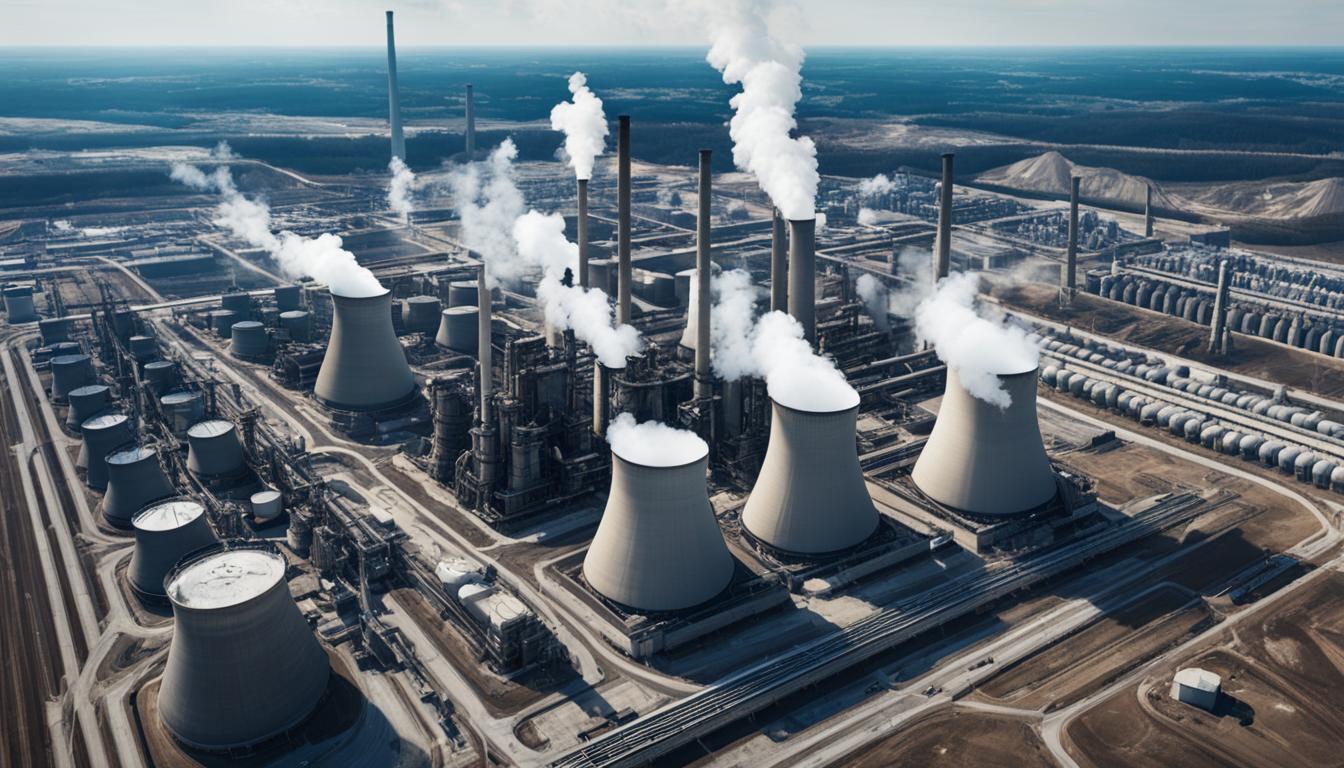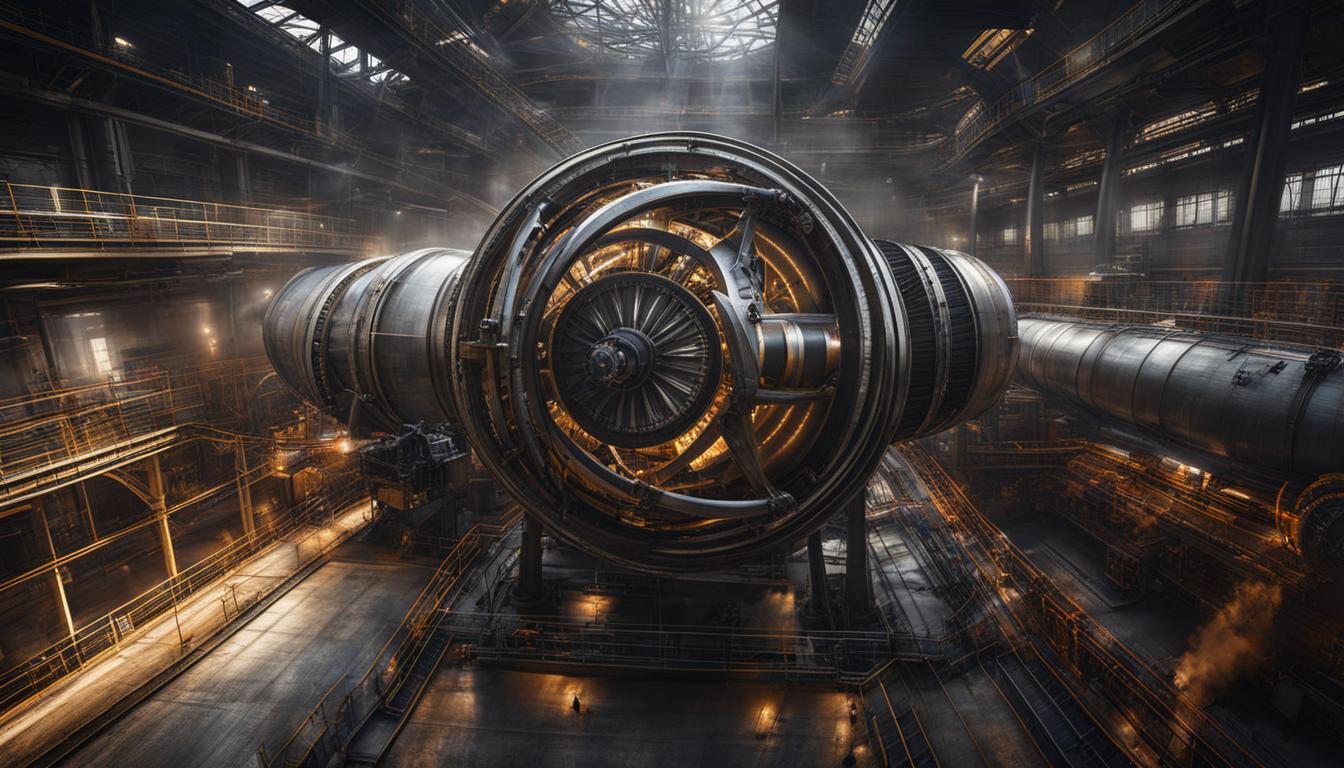A power plant is an industrial facility that converts various forms of energy into electricity. The process of generating electricity involves several components and technologies. One of the key elements is a turbine-driven generator, which is responsible for the actual production of electrical energy. Power plants can operate on different fuel sources, such as natural gas, coal, oil, or nuclear fuel. The heat generated by these fuel sources is used to produce steam, which drives the turbine. As the turbine spins, it rotates the generator, creating electricity through electromagnetic induction. This electricity is then transmitted through power lines to homes and businesses for consumption.
Key Takeaways:
- Power plants convert various forms of energy into electricity.
- Turbine-driven generators are crucial components in power generation.
- Power plants can operate on different fuel sources, such as natural gas, coal, oil, or nuclear fuel.
- Steam is used to drive the turbine, which in turn rotates the generator to create electricity.
- The generated electricity is transmitted through power lines for consumption by homes and businesses.
Types of Power Plants
Power plants are crucial in generating electricity from a variety of energy sources. Let’s explore the different types:
Nuclear Power Plant
Nuclear power plants utilize nuclear reactors to generate heat. This heat is then used to produce steam, which drives turbines and generators to generate electricity. Despite concerns about safety and waste disposal, nuclear power remains a significant source of energy worldwide.
Hydroelectric Power Plant
Hydroelectric power plants harness the energy of flowing water to generate electricity. By directing the force of rivers or waterfalls onto turbines, hydroelectric power plants convert the kinetic energy of water into mechanical energy, which is then transformed into electrical energy.
Solar Power
Solar power plants convert sunlight into electricity. Photovoltaic cells or solar thermal technologies are used to capture solar energy. Photovoltaic cells directly convert sunlight into electricity, while solar thermal technologies use mirrors or lenses to focus sunlight and generate heat, which is then used to produce steam or drive turbines.
Wind Power
Wind power plants harness the kinetic energy of the wind to generate electricity. Large wind turbines with rotating blades capture the energy from the wind and convert it into electrical energy through the rotation of the turbine’s rotor. Wind power is a clean and renewable source of energy.
Geothermal Power Plant
Geothermal power plants utilize the Earth’s internal heat to generate electricity. By extracting heat from the Earth’s core, geothermal power plants produce steam that drives the turbine and generator. This renewable energy source is highly sustainable and has minimal environmental impact.
Turbine Technology
Turbines are integral components in the process of power generation as they convert the energy of a moving fluid into mechanical energy, which drives the generator. Power plants employ various types of turbines depending on the energy source being utilized.
Did you know Allied Power Group keeps turbines running in tip-top shape? Learn more about our Component Repair services!
Steam Turbine
A steam turbine is commonly used in power plants fueled by coal, oil, or nuclear fuel. The process involves generating steam in a boiler, which is then directed onto the turbine blades. The force of the steam causes the turbine rotor to spin, generating mechanical energy that is further converted into electrical energy.
Combustion Turbine
A combustion turbine, also known as a gas turbine, plays a vital role in power generation. It operates by burning gaseous or liquid fuels to produce hot gases. These hot gases then power the turbine, causing it to rotate and generate mechanical energy for electricity production.
Wind Turbine
Wind power plants leverage wind turbines to harness the energy from the wind and transform it into rotational motion. The rotating blades of the wind turbine capture the kinetic energy of the wind, which is then converted into mechanical energy to drive the generator for electricity generation.
Combined Cycle Power Plants
Combined-cycle power plants are a highly efficient type of power plant that maximizes the use of fuel and reduces waste. These plants combine the operation of a gas turbine and a steam turbine in a sequential manner.
The hot exhaust gases from the gas turbine are directed to a heat recovery steam generator (HRSG), where they generate steam to drive the steam turbine. The addition of the steam turbine increases the overall efficiency of the power plant, as it utilizes the waste heat from the gas turbine. Learn more about Heat Rate Improvements here.
Combined-cycle power plants are capable of achieving high levels of efficiency in electricity generation.
Renewable Energy Sources
The shift towards renewable energy sources is gaining momentum as countries aim to reduce their carbon footprint and rely less on fossil fuels. Renewable energy offers a sustainable and clean alternative to traditional power generation methods. Let’s explore some of the key renewable energy sources:
Solar Energy
Solar energy harnesses the power of the sun’s rays to generate electricity. Photovoltaic cells, also known as solar panels, convert sunlight directly into electricity through the photovoltaic effect. Solar thermal technology, on the other hand, uses mirrors or lenses to concentrate solar energy into a fluid, which is then used to generate steam and drive a turbine. Solar power is abundant and widely available, making it a promising source of renewable energy.
Wind Power
Wind power utilizes the natural movement of wind to generate electricity. Wind turbines, which consist of large blades connected to a rotor, capture the kinetic energy of the wind and convert it into rotational motion. This motion is then used to generate electricity through a generator. Wind power is a clean and renewable energy source that has seen significant growth in recent years, with turbines installed in both onshore and offshore locations.
Hydroelectric Power
Hydroelectric power plants convert the energy of flowing water into electrical energy. By harnessing the force of moving water, hydroelectric power can generate large amounts of electricity. Water is stored in reservoirs and released through turbines, causing them to spin and generate electricity. Hydroelectric power is a reliable and renewable energy source, with some plants even having the ability to store excess energy for times of high demand.
Geothermal Power
Geothermal power taps into the Earth’s internal heat to generate electricity. This renewable energy source utilizes the natural heat stored within the Earth’s crust in the form of hot water or steam. Geothermal power plants extract the heat from geothermal reservoirs and use it to drive a turbine, which then produces electricity. Geothermal power is a reliable and consistent energy source, available 24/7 without being dependent on weather conditions.
By embracing these renewable energy sources, we can reduce our reliance on fossil fuels and mitigate the negative impacts of climate change. The transition to renewable energy is crucial for a sustainable future, helping to protect the environment and ensure a cleaner world for future generations.
Conclusion
Power plants are vital for meeting the ever-increasing demand for electricity in our daily lives. These plants employ a variety of technologies and energy sources to convert different forms of energy into electrical energy, which is essential for consumers. Whether it’s a traditional fossil fuel-based power plant, a nuclear facility, or a renewable energy plant, each type of power plant has its own unique process for generating electricity.
As we strive towards a more sustainable energy future, power plants play a pivotal role in shaping our energy landscape. By harnessing the power of various energy sources, they enable us to generate the electricity we need to power our homes, businesses, and communities. It is through the continued innovation and advancement of power plant technologies that we can achieve a balance between meeting our electricity needs and protecting our planet’s precious resources.
Frequently Asked Questions
How does a power plant work?
A power plant converts various forms of energy into electricity using turbines and generators. The heat generated by a fuel source, such as natural gas or coal, is used to produce steam, which drives a turbine. The spinning turbine rotates a generator, creating electricity through electromagnetic induction. This electricity is transmitted through power lines for consumption.
What are the different types of power plants?
There are various types of power plants, including nuclear power plants that use nuclear reactors, hydroelectric power plants that harness flowing water, solar power plants that convert sunlight, wind power plants that utilize wind energy, and geothermal power plants that extract heat from the Earth’s core.
What is the role of turbines in power generation?
Turbines play a critical role by converting the energy of a moving fluid into mechanical energy that drives the generator. In power plants, steam turbines are commonly used with steam produced by fuel combustion or geothermal heat. Gas turbines burn gaseous or liquid fuels, and wind turbines capture the kinetic energy of the wind.
What are combined-cycle power plants?
Combined-cycle power plants are highly efficient and utilize both a gas turbine and a steam turbine in a sequential manner. The hot exhaust gases from the gas turbine are directed to a heat recovery steam generator (HRSG), where they generate steam to drive the steam turbine. This increases the overall efficiency of the power plant by utilizing waste heat.
What are renewable energy sources?
Renewable energy sources include solar energy, wind power, hydroelectric power, and geothermal power. These sources harness natural and sustainable energy, such as sunlight, wind, flowing water, and heat from the Earth’s core, to generate electricity and offer a cleaner and more sustainable alternative to fossil fuel-based power generation.
Why are power plants important?
Power plants are crucial in generating the electricity that powers our everyday lives. They convert various forms of energy into electrical energy that is transmitted through power lines for consumption. As the demand for electricity increases, the development of efficient and sustainable power generation methods, including renewable energy sources, becomes essential for a cleaner and more sustainable future.


